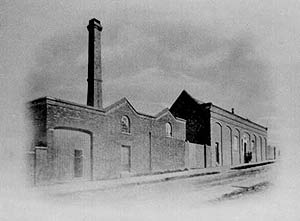![]()
The contents on this page remain on our website for informational purposes only.
Content on this page will not be reviewed or updated.
![]()
The contents on this page remain on our website for informational purposes only.
Content on this page will not be reviewed or updated.
|
HAYES BOATYARD - Ocean-going boats built miles from the sea |
||||
| Edward Hayes - Boatbuilder (1818-1877)
Edward Hayes was born in 1818 in Manchester (although some publications list his birthplace incorrectly as London). Following his apprenticeship where he qualified as a Boatbuilder and Agricultural Engineer, Edward moved to Wolverton the nearby town to Stony Stratford, to work on the 'London & Birmingham Railway'. |
 |
|||
| He had a varied young life, including being a school master of the 'British & Foreign Bible Society's School' located on the corner of the High Street and Wolverton Road in Stony Stratford. He married around this time. | ||||
 In the late 1840's he was already working as a Consultant Engineer when he started a small foundry with a forge called Watling Works (seen here) in Stony Stratford. It was an agricultural engineering firm which quickly grew in reputation. They developed mechanical equipment for farming use including a portable steam engine which could be operated by one man. At their peak the Hayes Boatyard employed more than 80 men. In the late 1840's he was already working as a Consultant Engineer when he started a small foundry with a forge called Watling Works (seen here) in Stony Stratford. It was an agricultural engineering firm which quickly grew in reputation. They developed mechanical equipment for farming use including a portable steam engine which could be operated by one man. At their peak the Hayes Boatyard employed more than 80 men.
He had an excellent apprenticeship programme which produced some great and talented engineers, one of whom went on to design for the doomed ship the Titanic. Some apprentices lodged in his own home at 8 Horsefair Green, Stony Stratford, where he lived before later building the house 'Mansfield' (now called 'Otley Bank' next to St. Marys Church on London Road). In the late 1860's work progressed following his steam engine success to making marine engines and then onto boat-building. Edward Hayes (senior) died in 1877 but had been part of the beginning of boat-building at Stony Stratford. By this time, Edward Hayes junior was receiving regular commissions from prestigious customers and went into production building tugs, ocean-going vessels, steam boats and river launches. Despite being almost as far away as you can be from the sea, and not next to any significant waterways, they gained a worldwide reputation and the boat-building flourished. By 1900 they were building vessels up to 80 feet long which were being sent all over the world to Russia, Egypt, etc, to private companies and to Governments. |
||||
 It must have been an amazing sight to see large vessels being towed by steam engines along Stony Stratford High Street from the Watling Works on the London Road through to 'Hayes Wharf' at Old Stratford. |
||||
 At the wharf, the boats were launched sideways down a slipway into the Grand Union Canal (called the Grand Junction Canal up until 1928). |
||||
| The boats were dismantled and towed along the waterways to London for refitting and would then sail to their destination elsewhere in the world. Larger vessels were assembled in prefabricated pieces - pioneering stuff at that time!
Boat-building continued successfully but Edward Hayes (junior) died in 1917 and his son died early in 1920, and the curious inland boatyard continued for only five more years. The last vessel, the Sparteolus, a river Thames tug was dispatched to London in 1925, marking the end of an era... |
||||
|
Epilogue
|
||||
One of the last orders to the Hayes firm had come in December 1923.. Destined for a working life on the Thames, this boat was named the Pat (after one of Hayes' daughters). The archive photo on the right shows her taking the same journey as all her predecessors - down Stony Stratford High Street from the works, and heading for the launch into the canal at Old Stratford. The names "Pat" and "London" can just be discerned on the stern. |
||||
| In the period after the Second World War, the Pat became the flagship of the Thames Water Conservancy Board. The boat was renamed the Wey - following the Board's policy on naming its boats after local rivers. | ||||
Hearing that the Wey was to be decomssioned. Milton Keynes Museum asked if it might be the custodian of the boat, which would thus be brought back to the area of its creation eighty years previously. After due discussion and arrangements, it was agreed that the boat would return, and a local firm agreed to sponsor the move with the provision of appropriate lifting and transport facilities. The Photo on the left shows the Wey moored at Sunbury, shortly before its move to Milton Keynes. |
||||
(Right) Twin Cranes lift The Wey onto the prepared cradle in the Museum car park on December 23rd 2004 (Below) The Wey at Milton Keynes Museum. It will be moved to a prepared site next to the Museum's Hall of Transport in mid-2005, when the ground has dried and hardened enough to take the weight of the cranes.
|
||||
|
|
||||
|
|
||||